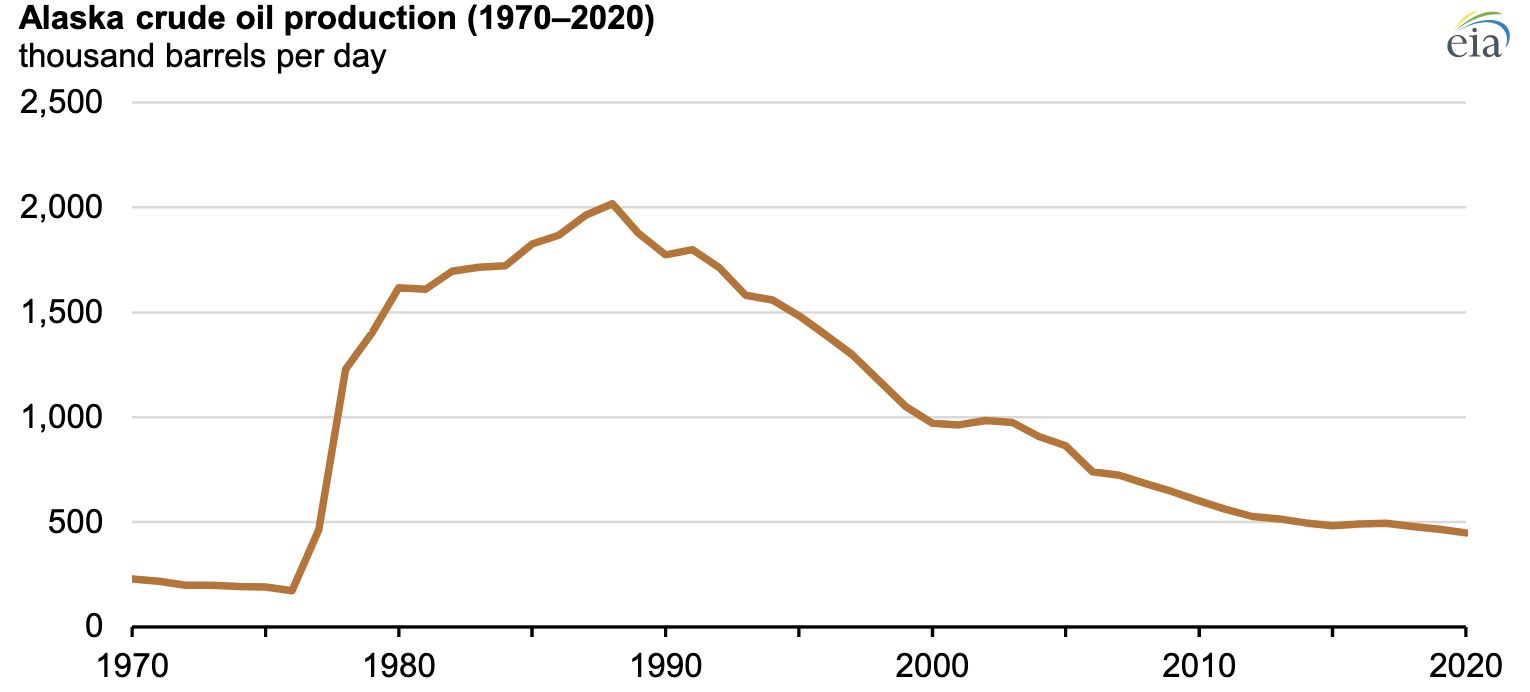President Biden’s policies and executive orders are hurting oil-producing states, including Alaska. Congress approved oil and gas drilling in the Arctic National Wildlife Refuge (ANWR) in northeastern Alaska in 2017. Biden, however, signed an executive order placing a temporary moratorium on oil and gas activity in the refuge on January 20, 2021, one day after the Trump administration issued nine oil and gas leases in its coastal plain. ANWR is estimated to contain 10.4 billion barrels of crude oil, according to U.S. Geological Survey, and could help the state’s revenues as oil production is the largest contributor to the state’s economy. Alaska’s oil production is now at its lowest level in 40 years, which threatens the operation of the Trans-Alaskan Pipeline System (TAPS) that transports crude oil from the North Slope of Alaska to Valdez on Alaska’s southern coast.
Oil Production in Alaska
Crude oil production in Alaska averaged 448,000 barrels per day in 2020–the lowest level of production since 1976 and 4 percent less than in 2019. Alaska’s oil production in 2020 was over 75 percent less than the state’s peak production of over 2 million barrels per day in 1988.

Trans-Alaskan Pipeline System (TAPS)
Pipeline deliveries via TAPS have slowed because of the lower oil production, which causes oil to move more slowly in the pipeline. As a result, the travel time for oil to be transported from the North Slope to Valdez has increased from 4.5 days in 1988 to 18 days in 2020.
Because TAPS was designed to move warm oil in an Arctic environment, the slower flow rates can cause problems: oil and water may separate during transit and because oil cools during longer transit times, potential ice formation and additional wax accumulation may result. At low velocities, water separates from the oil and may create a corrosive environment because the separated water, in conjunction with wax deposition on the pipe wall, can increase internal corrosion. During cold weather shutdowns, water can accumulate and freeze, causing problems when oil flow resumes.
The simplest solution to TAPS’ technical challenges is to increase the oil throughput, which means that Biden needs to allow more oil production in Alaska.
Alaska’s Economy
Alaska has no state income or sales tax and instead relies on revenues from the oil and natural gas industry derived almost exclusively from state-owned lands on the North Slope. Oil revenues supplied more than two-thirds of the state’s budget in 2020. Although Alaska relies on the oil and natural gas industry for its revenue base, production in the state makes up only 4 percent of all oil production in the United States. Since 1982, every eligible state resident has received an annual dividend from the Alaska Permanent Fund, which manages royalties the state receives from its mineral rights, which is primarily from oil.
Alaska’s Energy Use
Alaska has the third-highest petroleum demand per capita of any state. In 2020, Alaska consumed more petroleum for electricity generation than any state except Hawaii. This is in part due to localized diesel generation that serves Alaska’s approximately 240 remote villages unconnected to a grid in a state over twice the size of Texas. Petroleum accounted for 16 percent of the state’s utility-scale generation, the third most of any generation source behind natural gas (38 percent) and hydroelectric power (31 percent). Almost one-third of the state’s households rely on petroleum products such as fuel oil, kerosene, or propane for heating.
Conclusion
Alaskan households rely on petroleum products for heating fuel and the states’ utilities use it as a generating fuel. Alaska’s government relies upon oil revenues for a higher proportion of its budget than any other state, by far. But, oil production in Alaska is declining and more areas need to be opened to exploration and drilling to supply the state and other areas of the United States with oil and to keep TAPS operating efficiently. Congress approved ANWR to be opened in 2017, but Biden “paused” oil development there solely by executive order. It can take 7 to 10 years to develop an oil field. This is not the time to procrastinate if Americans are to reap the benefits of its oil resources and TAPS, which began operating in June, 1977, to supply Americans with oil.